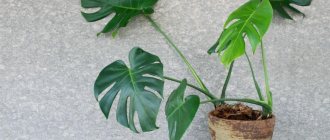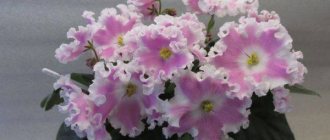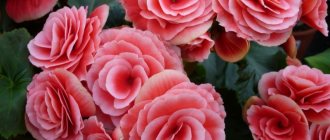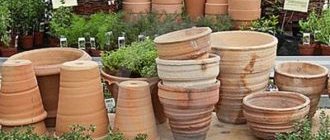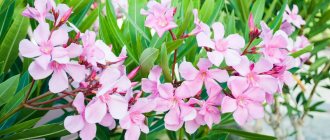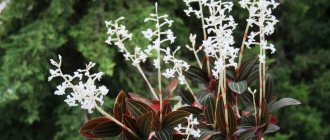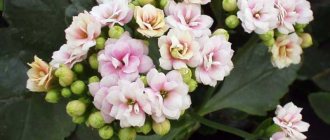Author: Elena N. https://floristics.info/ru/index.php?option=com_contact&view=contact&id=19 Category: Houseplants Published: February 24, 2019Last edits: January 11, 2021
- Growing from seeds
- Monstera turns yellow
- Monstera deliciosa, or attractive (Monstera deliciosa)
Monstera is an old favorite of ours. This luxurious plant can enhance any interior. Even its notoriety does not hinder the growth of its popularity: superstitious people consider the monstera to be an energy vampire that attracts misfortune to the house.
The reason for these speculations is the aerial roots of the plant, which in nature sometimes form entire thickets. And also fruits that leave your mouth feeling like the pricks of many needles. But at home, Monstera does not bloom, so it does not form fruits.
- What conditions does Monstera need for growth and development?
- How to grow monstera at home?
- How to transplant and reproduce it?
You will find answers to these and other questions in our article.
Planting and caring for monstera
- Flowering: the plant is grown as an ornamental foliage plant.
- Lighting: bright diffused light or partial shade.
- Temperature: in summer – normal for residential premises, in winter – 12-14 ˚C.
- Watering: regular and plentiful: the substrate should be slightly moist all the time.
- Humidity: high. It is recommended to regularly spray and wash the leaves with a damp sponge.
- Feeding: from March to August twice a month with complex mineral fertilizer for decorative deciduous plants; during the rest of the year, Monstera does not need fertilizing.
- Rest period: not clearly expressed.
- Transplantation: young plants are replanted annually, four-year-old plants - once every 2-3 years, old ones - once every five years, but the top layer of substrate up to 5 cm thick must be changed in pots of large plants annually.
- Garter: the vine is tied to a support dug into the potting soil - a ladder, a tube filled with moss or an artificial trunk wrapped in copra.
- Reproduction: sometimes by seeds, but more often vegetatively (cuttings and shoots).
- Pests: ivy scale insects, thrips, mealybugs and spider mites.
- Diseases: sooty fungus, stem rot.
Read more about growing monstera below.
plant (lat. Monstera) is a large vine and belongs to the Araceae family. In nature, monstera flowers grow in the tropical forests of the equatorial regions of Central and South America from the Yucatan Peninsula and Mexico in the north to Brazil in the south. At the end of the 18th century, the monstera flower was introduced to Asia, and then spread throughout Europe and Australia. I would like to believe that the name Monstera comes not from the Latin word Monstrum, meaning monster, but from monstrosus, which means “amazing, bizarre,” but the myths that haunt the plant cast doubt on this.
- Gerbera: home care
European explorers of the South American tropics were not so much surprised by the tree as they were frightened: the monstera vine is of such impressive size that it looks intimidating. And where fear arises, legends are born, for example, that the monstera is an energy vampire, that the roots of the monstera entangle the victim and strangle him, and all that. Let’s not retell fables, but rather let’s talk about what the monstera indoor flower actually is in modern floriculture.
Air temperature
Since Monstera in natural conditions is an inhabitant of the equatorial part of Central and South America, it requires similar conditions at home. The plant feels comfortable when the thermometer readings are from 25 to 28 °C in summer, and from 16 to 18 °C in winter. Moreover, if in the hot season the temperature rises above 27°C, you need to take care of increasing the humidity and increasing the frequency of watering. And in winter, when the temperature drops below 16°C, the frequency of watering must be reduced. Monstera does not like drafts and sudden temperature fluctuations.
Botanical description
So, the indoor monstera is an evergreen plant, a long-time favorite of gardeners who appreciate its exotic beauty and ease of care. Monstera at home grows to four meters in length, literally within 5-6 years, but since the plant is a vine, it needs stable support. In addition, using a support is very convenient, since a large monstera takes on the shape of a tree and takes up less space, and also looks more impressive. Carved monstera leaves reach a diameter of 45 cm, and young leaves are whole, but over time holes appear in them, and the larger the leaves become, the more slits there are in them.
In addition to the ordinary roots with which in nature the vine grows as an epiphyte to a tree, the aerial roots of the monstera are also of great importance, reaching right down to the ground and feeding the plant from the soil. Monstera blooms in the same way as other araceae, with an inflorescence similar to an ear of corn wrapped in a blanket. The monstera fruit is a berry about 20 cm long with a banana-pineapple flavor. By the way, in Australia, monstera is bred precisely for its nutritious and tasty fruits. But a monstera grown indoors is unlikely to be able to treat you to a delicious fruit, since monstera blooms infrequently at home.
Monstera deliciosa: features of the name
The scientific name of the plant “monstera” comes from the Latin word, which means “monster”. This vine received such a strange name, to put it mildly, mainly because of its impressive size - in nature its length can reach 9 meters. But the specific name “delicacy” was given to it thanks to its amazing, very tasty fruits. This is evidenced by the fact that the daughter of the Emperor of Brazil, Princess Isabella of Braganza, called this monstera the main attraction of her country.
Among the people, Monstera deliciosa is often called the “cheese plant”, since its perforated leaves are very reminiscent of Swiss Emmental cheese, with characteristic, round holes. But in Spain and Portugal it is better known as “Adam’s rib”.
Monstera - can you keep it at home?
Readers sometimes ask why Monstera cannot be kept at home. And really - why? I don’t know who and when examined the monstera for the presence of vampire properties or toxins, but personally I didn’t notice anything like that in it. The only factor that makes you think about whether to keep a monstera in the house is its size. A beautifully formed monstera tree grew in my house for several years, until I had to part with it because it, and not me, became uncomfortable - the monstera no longer had enough space in my modest apartment.
I gave the plant, which had become too large, to my friend, and she placed it in the lobby of her restaurant, which the monstera still decorates to this day. But if you are sure that keeping a monstera in the house is harmful, well... there are many other plants that are no worse. Well, for those who, like me, believe that Monstera can be kept at home, I recommend, just in case, not to place it in the bedroom or nursery.
Interesting facts about Monstera latissimus
Monstera - why you can’t keep it at home and its effect on humans
The berry is quite tasty and nutritious, so this variety is now grown as a fruit-bearing plant in areas with the appropriate climate. In the Indian and Australian states, monstera began to be cultivated precisely for the purpose of obtaining its fruits.
Note! The founder of the tradition of using monstera fruits as a dessert was Princess Isabella of Braganza of Brazil, daughter of Emperor Pedro II.
Monstera fruit composition:
- proteins - 1.8 g;
- fats - 0.2 g;
- carbohydrates - 16.2 g;
- fiber - 0.57 g;
- water - 77.9 g
The calorie content of Monstera deliciosa is 73 kcal per 100 g.
Is Monstera poisonous or not?
The intercellular space of the leaves of this plant contains thin needle-like formations of calcium oxalate (raphida). When they come into contact with mucous membranes, they cause severe burning and irritation. If a child or animal eats even a small part of the leaf, toxic poisoning is inevitable. Particular care should be taken if you have a cat, dog or parrot at home, which may want to nibble on indoor flowers. Symptoms: numbness and irritation of the mucous membrane of the mouth and pharynx, pain, swelling, aphonia (loss of voice).
Note! The answer to the question whether a monstera flower is poisonous or not will be negative. And its fruits, as mentioned above, are edible.
Is it possible to keep Monstera deliciosa at home?
Doubts are associated with numerous myths about the influence of the flower on a person’s fate, about the monstera’s ability to absorb oxygen, etc. But all superstitions are not confirmed by anything. There is no need to be afraid of growing monstera at home. It is quite safe, despite the threatening name.
Monstera deliciosa fruit
Caring for Monstera at home
Growing conditions
Monstera is unpretentious, and caring for it is not burdensome. If you want the leaves of the plant to be decorated with fancy holes and slits, provide it with bright, diffused light. As a last resort, keep it in partial shade, but full shade will not benefit the decorative qualities of the plant. In summer, the monstera will be satisfied with the usual temperature for this time of year, but in winter it is advisable to give it a break from intensive growth and provide coolness - 12-14 ºC. Protect the plant from drafts and sudden temperature changes.
- Pruning plants (Part 1): is it necessary to prune? Why trim?
The soil of Monstera should always be slightly moist, and watering should be carried out based on this principle. If the monstera is in a room with central heating in winter and a temperature that is comfortable for you and not for her, then you will have to water the plant as often as in the summer. But if you place it in a cool room, then watering can be reduced. Water for humidification is used that is settled or filtered, without any admixture of lime.
High air humidity is very important for Monstera, so be prepared to frequently spray and wash the leaves of the plant in the warm season, but if you suddenly notice spots of moisture under the Monstera pot, this is a sign for you that you have overdone it with moisturizing the leaves. This ability to remove excess moisture through the leaves is called guttation. The monstera usually “gots” before rain or when the air in the room is too humid, which is why the monstera is popularly called a crybaby. In winter, replace leaf spraying with hygienic dusting and polishing of leaf plates.
Fertilizer
In the warm season, from March to August, Monstera is fed twice a month with Agricola, Nitrophoska, Seramis, Effecton or other complex fertilizer for decorative foliage plants. As soon as it gets cool, fertilizing is stopped and resumed only at the beginning of the next growing season.
Transfer
Young monstera specimens are replanted annually, those that have reached four years of age - once every 2-3 years, adult monsteras are replanted once every five years, but the top layer of soil (about 2.5 cm) must be replaced with fresh substrate annually. You need to take a larger pot for the monstera, as they say, “for growth,” since the monstera grows very quickly. The soil should be loose, light, but fertile, as for violets, for example.
The composition can be approximately this: two parts of turf soil and one part each of peat, perlite (or coarse sand), humus (or leaf soil). Experts suggest adding sphagnum, bark and charcoal to the substrate. Of the ready-made soils for Monstera, “Terra” or a mixture for palm trees is suitable. How to transplant a monstera? A thick layer of drainage is placed in the pot, then the Monstera root ball is carefully transferred and the container is supplemented with the required amount of substrate.
Monstera support
Since Monstera is a large vine, in adulthood it will need support - a wooden or plastic ladder, an artificial trunk wrapped in copra, but it is best to use tubes with holes for this purpose: the cavity of the tube is filled with moss, which is kept wet all the time, which will give additional moisture to adventitious roots. Try to direct the ends of the aerial roots into the holes of the tube - this will provide the plant, in addition to moisture, stability.
Monstera. Do you know the taste of this delicacy?
I first saw this plant with a “monstrous” name back in 1979 - in a book about indoor plants that was given to me.
The photo amazed me - never before had I seen a plant with such intricate and at the same time graceful leaves (at that time my knowledge did not extend beyond geraniums and cacti)...
But the description of this plant simply shocked me!
Among other things, just imagine - its edible inflorescences look like a banana and a pineapple at the same time!!!
In a word, I started dreaming about this plant... And lo and behold! A couple of years later, while walking along the central avenue of my Ural city, I saw the coveted plant in the window of the city children's library... After several visits to kind librarians, I managed to persuade one of them to take a cutting.
The cutting, placed in a jar of water, quite successfully produced roots. And since then, Monstera deliciosa has settled with me. She went through many moves, but two of them were particularly extreme.
The first extreme move took place in early October 1983. By that time, I had already gotten married, and my husband and I, having received our diplomas, went to the Far North. Our things (including some furniture, indoor plants (sansevieria, hoya, arrowroot, dieffenbachia... I didn’t have Crassula at that time) and two bags of potatoes were sent by container by rail
When we arrived in the glorious city of Lesosibirsk, there was snow there... Accordingly, one can imagine in what condition our “things” arrived a week later... When the plants and potatoes began to thaw, there were a lot of tears and... a bad smell (since we hoped to save at least some potatoes, they didn’t throw them away right away...). Surprisingly, it turned out that only the above-ground part of the plants died - the roots survived and gave me new shoots!
I prepared the second extreme journey (now to Novosibirsk) for our plants thoroughly, taught by a long-standing sad experience; before loading them into the container, I cut them all “down to the stump”... As a result, they arrived safely - gradually they all gave new shoots and took on a quite decent appearance. You have already seen my magnificent monstera in the first photo
Description of the plant
Monstera is a large evergreen tropical vine of the araceae family.
Homeland - South America. In our country it is grown as an ornamental foliage plant. Adult specimens have a curved, thick, woody stem. It has large (at home up to 30 cm in length) leathery leaves of a rich green color - each fan-shaped dissected leaf is unique in its shape
But the first leaf on each new shoot does not have cuts - but its shape resembles a heart. The reverse side of the leaf, matte and lighter, has small dark and very graphic veins
Numerous aerial roots give the plant uniqueness and a special exotic charm - you can help them grow to the ground - this will not only decorate it, but also give the plant additional nutrition
Monstera leaves are very poisonous - chewing them by a person or animal can cause poisoning. Typical symptoms of this poisoning are numbness and irritation of the mouth and throat, painful swelling, and loss of voice.
But this vine has edible inflorescences! Under favorable conditions, Monstera is able to give its owners unique “fruits”, for which this plant is grown in tropical countries. [My monstera still hasn’t made me happy with either the taste of banana or the smell of pineapple. Do you know the taste of this delicacy?]
Growing conditions
Monstera prefers moderation in everything:
- loves moderate lighting - place it on an eastern or western window (in direct sun it can get burned, and on a northern window the leaves will become smaller and lose their cutness),
- loves moderate watering - do not overfill it with water or overdry it,
- loves moderate heat - at a temperature of +20...+25°C she feels great,
- loves moist air - like any tropical plant, in summer at temperatures above +26°C the vine responds well to frequent spraying with clean, settled water,
- loves neutral soil.
Planting and transplanting
A large vine requires a large, stable pot and support.
But when planting a small cutting, choose a small pot. Drainage is required - it can be expanded clay, gravel, small crushed stone or foam chips. You need neutral soil with approximately the following composition: turf soil, leaf soil, peat, humus and sand in a ratio of 3:1:1:1:1. You can buy a special soil for aroid plants or a universal flower soil. Replanting - when the roots grow - by transshipment. Until the age of 4, the monstera is replanted annually - each new pot is 3-4 cm larger than the previous one. Then replanting is required much less frequently - once every 3-4 years, but it is recommended to replace (renew) the top layer of soil. [Although personally, I don’t really understand how to do this, taking into account the attached aerial roots... I mulched the surface of the soil with small crushed stone... Do you like it? I do not like? ]
Reproduction
Monstera reproduces in several ways.
The first of them is a seed one, which is unlikely to occur at home. Therefore, although it is possible for the lucky owners of seeds, I will not dwell on it.
The second method - using side shoots - is the simplest and most reliable. Carefully separate the side shoot from the base of the stem, powder the cut with crushed activated carbon and plant it in a prepared pot with suitable soil, setting up a small greenhouse using a plastic bag. Substrate - moisturize. The greenhouse should be ventilated. You will know about the success of rooting by the young sprouts that appear.
The third way is using cuttings. This is exactly what I used when I rooted Monstera as gifts for my new Novosibirsk friends. It is necessary to select a shoot that has at least one mature leaf and several aerial roots. Without cutting the selected shoot, place it in a container of water. After receiving a whole “scourer” of normal small, white roots, cut off the upper part of the shoot below the roots, powder the cut with crushed activated carbon and plant the resulting seedling in a prepared pot, completely burying all the roots into the soil.
The fourth method is by apical cuttings. Find and cut off the top of the mother plant, always with several leaves and a bud eye. Leave it to root in damp sand or a mixture of sand and peat, covered with a plastic bag for about 30 days. Substrate - moisturize. The greenhouse should be ventilated. After 30 days, transplant the rooted plant to a permanent place of residence in a prepared pot with suitable soil. [You don’t need to worry about the mother plant - it will begin to grow due to the dormant buds!]
The fifth method is using cuttings from the middle of the shoot. As usual when cutting, make the upper cut above the bud - straight, the lower - oblique. Powder both cuts with crushed activated carbon. Plant the prepared cuttings in a substrate made of a mixture of peat and sand (1:1). Substrate - moisturize. The greenhouse should be ventilated. After about a month, transplant the rooted plant to a permanent place - into a prepared pot with suitable soil.
Attention! It is not recommended to root cut cuttings in water [remember, this is how, out of ignorance, I rooted my very first cutting, obtained from the library] - roots grown in water this way are very difficult to adapt to in the soil, and the plant gets sick for a long time.
Watering and fertilizing
As I said above, this plant needs moderation in everything.
The same applies to watering: water with moderately settled warm water. Feeding - from March to September - with complex mineral fertilizer for decorative deciduous plants once every 2-3 weeks. You should not fertilize in winter.
Features of cultivation and care
Our vine, of course, needs support.
[I have this coconut support - it has been in use for a long time, it has never been changed. I also have a garter - to the cornice using hemp rope]. The pot, as I said above, must be heavy and stable - its width is almost equal to its height. For such a luxurious plant, of course, you need to choose a gorgeous pot. [Mine is clay, handmade]. Monstera needs systematic bathing - regularly wipe the large carved leaves with a damp cloth or sponge. This is necessary in order to prevent disruption of photosynthesis, as well as gas exchange between the plant and the environment due to the clogging of pores on the leaves of the plant with dust.
Your plant will be decorated by polishing the leaves, which can be done using a special product or at home - adding a little milk to the bathing water.
Pests and diseases
With proper care, your vine will be healthy and beautiful.
This is exactly what I currently have. But in general, there are quite a lot of diseases and pests in monstera. And I had to overcome almost all of them during these long, long years of our life together:
- Spider mite. The leaves are turning yellow and cobwebs have appeared on their reverse side. We urgently increase the humidity of the room by spraying (or a humidifier), washing the plant, and also using acaricides, for example, a biological product, to combat the pest - exactly according to the instructions.
- Shield. My beloved monster overcame this scourge for a long time and persistently. As stated, the most reliable, safe and environmentally friendly means of protection and disposal is green soap. But this remedy did not help me even once out of 7, 17... (or 77?!) attempts. No amount of washing or picking up these reptiles by hand helped - this remedy saved me and the monstera - 8 arrows of the “Doctor” drug saved us from the scale insect once and for all!
- Mealybug. A white coating appears on young shoots and leaves, the leaves dry out and fall off... Urgently wash the plant and treat it similarly to the previous case.
- Thrips. Formed in a hot, dry room - the affected leaves become gray-brown. Treatment is similar.
- Root rot. [And we had this too. True, not a house plant, but a daughter plant that I planted at work...] Reasons: too large a pot, waterlogging and acidification of the soil and, as a consequence, lack of oxygen. The root system begins to rot, the plant loses turgor, the leaves droop, wither and die. We treat it like this: remove the plant from the soil, wash the roots, remove rotten ones, powder the cut areas with crushed activated carbon, treat the whole roots with a manganese solution. We plant the cured monstera in a smaller pot with new soil (throw away the old one!).
- Yellowing and drying of leaves. Occurs due to insufficient nutrition. You should feed the plant with complex mineral fertilizer for ornamental foliage plants, but at a slightly lower dosage than indicated in the instructions.
- The leaves lighten, then turn yellow and become translucent - chlorosis! If you urgently need iron chelate, use it according to the instructions.
- Monstera is crying. Droplets of water flow from the tips of the leaves - due to waterlogging during watering. The plant strives to get rid of excess moisture in this way. Reduce watering!
- The leaves began to look like brown paper. She felt cramped in the old pot - we urgently transplant her into a larger pot!
Interesting Facts?
I could tell you from which “monsters” the name of the plant came (there are several options)... Or tell you that many variegated forms of monstera have already been bred... Or describe the amazing fruit that the plant gives to its especially diligent owners (my monstera did not bloom, but you can’t take a photo from the internet)… Or here’s another thing - you can warn that it is not recommended to keep the monstera in an apartment - supposedly it emits some kind of negativity (but I don’t believe in such slander from plants - in my subjective opinion, some people tend to abdicate responsibility and attribute “fault” to plants) Friends, all this can be found on the Internet!
So what? I have already told the story of the appearance of the monstera in my family and its long-standing adventures above. It has long become a familiar part of the house... However, with the advent of our Garden and my new gardening passion, this rather overgrown (despite its pruning) vine is now becoming quite burdensome. Judge for yourself: closer to spring, you need to make room for seedlings... Monstera, together with its neighbor, sansevieria, moves from the windowsill to a high stool (with some other unimaginable stands)
And for five months a year we generally live outside the city - my monstera often experiences serious drying out, waiting for our rare, fussy arrival. About fertilizing... [attention: from March to September! ] it’s hard to say at all... Well, maybe in March...
Monstera reproduction
Monstera reproduces by seed and vegetative methods.
- Beautiful photos of croton leaves
Growing from seeds
How to propagate monstera by seed? Moist sphagnum moss is placed in ziplock bags, seeds are added, the remaining volume is filled with air and the zipper is closed. The percentage ratio is approximately this: 5% moss with seeds, 95% air. Crops are kept in a bright and warm (25-28 ºC) room. Shoots appear in two weeks or a month, and after the seedlings develop two leaves, they are planted in containers with a substrate of the following composition: one part each of sand, leaf and turf soil. Seedlings are grown at a temperature of 25 ºC in bright diffused light, transplanted into a new pot every year.
Propagation by cuttings and shoots
How does monstera reproduce besides the seed method? After all, its seeds do not have good germination, and it takes a very long time for Monstera to grow from seeds. That is why amateur flower growers prefer a faster and more reliable method of propagation - vegetative. This monstera breeding takes place from March to June. Parts of the stem with one or two leaves, the top of the trunk or lower side shoots are used as cuttings.
Monstera cuttings or its top are rooted in water under bright diffused light at a temperature of 25 ºC. The water must be changed every two weeks. After a few weeks, roots will appear, let them grow, and then transplant the cuttings into soil to sow seeds. When the monstera leaf regains its elasticity, you can feed the rooted cuttings with complete mineral fertilizer at the rate of 1 g per 1 liter of water. Some gardeners immediately plant cuttings in the ground and cover them with glass jars, thus creating a greenhouse effect. After 3-4 years, the young, strong plant is transplanted into a spacious pot.
Transplanting a plant
Monstera grows quickly and requires regular replanting. The plant is first replanted at an early age, and then annually until the age of 4–5 years. After this period, it is permissible to change the container and soil every 3-4 years.
Soil requirements for monstera
When selecting soil, it is necessary to recreate the soil composition in the tropics as much as possible. The easiest way is to purchase substrate for monstera and palm trees at a flower shop. However, the soil mixture can be prepared at home:
- Combine peat, humus, sand, turf and leaf soil in a ratio of 3:2:1:1:1.
- Turf soil, peat, sand, humus (1:1:1:2).
- Sand, humus, leaf and turf soil (1:1:1:3).
The soil should be light and loose, and the substrate should occupy at least a third of the volume of the pot when planting.
Pests and diseases
You won’t have any problems in this regard with Monstera: it is extremely rarely affected by pests, and it is also resistant to diseases. And only the most careless owners can subject the plant to attack by scale insects and spider mites, whose presence is not so easy to notice. If you do find pests, try wiping the monstera leaves with a soapy solution, but if this does not help, you will have to apply an insecticide treatment - actara or fitoverm.
But what to do if the leaves of the monstera turn yellow and then become transparent? This is a sure sign of chlorosis, so you need to buy Iron Chelate and use it according to the instructions. In lazy owners who violate the rules for caring for monstera, the plant may suffer from fusarium, late blight, anthrachnose, bacterial and stem rot, and spotting.
Monstera turns yellow
Usually, the monstera reacts to all mistakes and shortcomings in care by changing the color of the leaves - yellow spots on the leaves of the monstera are a sign that the plant is dissatisfied with your care. Why does Monstera turn yellow?
There are many reasons for this:
- if the leaves turn yellow en masse in winter, it means that you have overdone it with watering;
- if, along with yellowing, brown spots appear on the monstera, it seems that this is a case of insufficient moisture;
- if the leaves not only turn yellow, but also fall off in large numbers, this is the result of too high a temperature and insufficient air humidity in the room;
- The leaves become yellowish-pale if the plant suffers from excess light.
What to do if the monstera turns yellow? Find out the cause and eliminate deficiencies in plant care.
Monstera dries
Sometimes only the tips of Monstera leaves dry out, and sometimes necrosis spreads along the entire edge of the leaf, which negatively affects the decorative appearance of the plant.
And in this case, the question of why the monstera dries out may have several explanations:
- drafts or a stream of air from the air conditioner falling on the leaves of the monstera;
- indoor air that is too warm, too cool, or too dry;
- stagnation of water in the roots, watering in the dark or, conversely, in direct sunlight;
- The lower leaves quickly wither and dry out if the plant needs replanting.
Monstera turns black
There are also several explanations for this phenomenon. The leaves turn black when the Monstera has an unbalanced watering regime: from a lack of moisture, the leaves first turn yellow, then darken, and from an excess, blackness appears on the green leaves, and in the second case, the rot can be either dry or wet. To find out why the monstera turns black, just watch it: if during observation you find guttation, then you need to immediately reduce watering so that the leaves do not turn black later.
Reproduction
Monstera propagates by seeds, cuttings and air layering:
- When propagating by seeds, light and warmth are needed. Seeds are placed in soil or damp moss. They should emerge in a month. It is recommended to leave the planting material overnight in a growth stimulator.
- When propagated by cuttings, stem or lateral shoots are planted in a pot under glass. Cuttings should be short with 1-2 leaves. A cut is made at a right angle on top, and an oblique cut on the bottom. Plantings should be watered and sprayed as the top layer of soil dries. The plant takes root and is placed in a pot.
- A layer with an aerial root and a leaf is planted in a pot.
Types and varieties
The Monstera genus is quite diverse in nature - about 25 species, but only two of them are grown in culture.
Monstera deliciosa, or attractive (Monstera deliciosa)
In greenhouse conditions it can grow up to 12 meters in height, in a room - only up to three meters. With good care it can bloom every year, but the fruits ripen only in a greenhouse. A variegated form (variegata) has been developed, which is more demanding of care, but does not grow as quickly as the main species. Also popular is the delicious variety Borsigiana, or Monstera Borsiga, bred from Monstera - not as powerful a plant as the original species.
Monstera oblique, or unequal-sided (Monstera obliqua)
A plant from humid Brazilian forests with graceful lacy elliptical leaves up to 20 cm long and 6 cm wide. The leaves are entire, unequal at the base, with a short petiole (12-13 cm), on a short peduncle (7-8 cm) there is a few-flowered inflorescence 4 cm long, but this species does not bloom in cultivation.
Monstera deliciosa: where it grows
The natural habitat of Monstera deliciosa is located in South and Central America. In the wild, it still often grows in humid, tropical forests, lowlands and mid-mountains in Brazil, Honduras, Colombia, Mexico, Costa Rica, Uruguay and Guyana. It grows primarily under dense forest canopy, creeping along the ground or climbing tree trunks.
In culture, Monstera deliciosa is grown almost everywhere around the globe as an extremely rare fruit and ornamental plant. In countries with a humid, tropical climate, it is cultivated as a fruit and ornamental garden plant, and in regions with a subtropical and temperate climate - as an indoor, decorative-leaved perennial.
FAQ
Monstera leaves become paler. What is the reason?
If the naturally lush green leaves become lighter and paler, this is an indication that the plant is not getting enough nutrients. It is necessary to increase the dosage of fertilizer and introduce nutrients every week for some time. If the desired result is not achieved, the monstera is transplanted into a fresh substrate.
Unsightly brown spots appeared on the leaves. What is the reason?
Brown or reddish-brown spots indicate sunburn. Young plants are especially sensitive to direct sunlight. Monstera recovers quickly in a partially shaded area. If the spots feel soft and spongy, the plant is signaling that it is getting too much water. It is necessary to either reduce watering or transplant the monstera into a fresh substrate, cutting off the rotten roots in advance.

